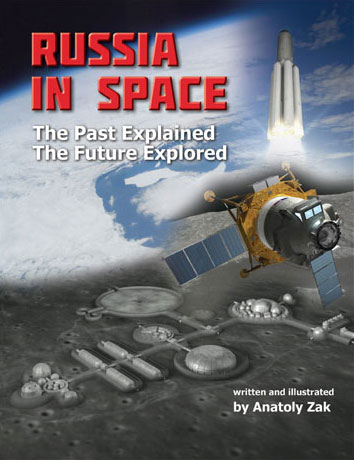First launch from Vostochny (original) (raw)
Soyuz completes historic first mission from Vostochny
Inaugurating the new Russian spaceport of Vostochny in the country's Far East, a Russian Soyuz-2 rocket delivered a trio of satellites into the Earth's orbit. The historic liftoff marked the beginning of a gradual shift of Russian space activities from Baikonur Cosmodrome in Kazakhstan to the Russian territory.
Previous chapter: Soyuz rocket for Vostochny
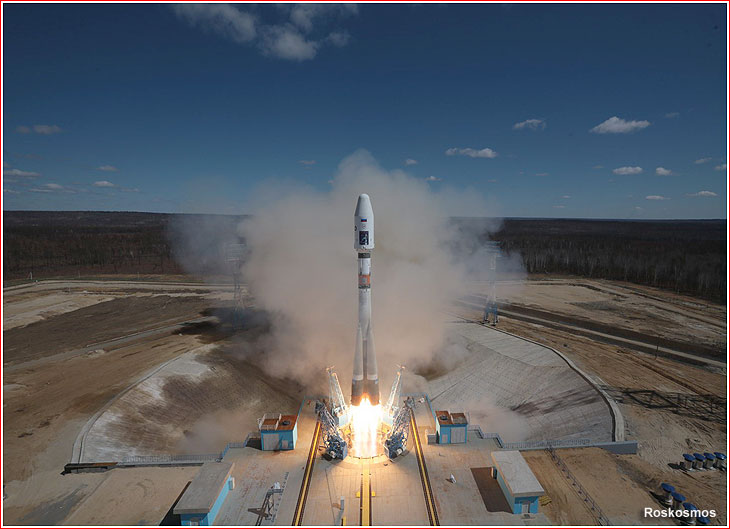
A Soyuz-2 rocket lifts off on the first mission from Vostochny on April 28, 2016.
From the publisher: Pace of our development depends primarily on the level of support from our readers!
Payloads
Along with its primary payload -- the Mikhailo Lomonosov scientific spacecraft -- the first mission from Vostochny also carries the Aist-2D (198KS) experimental remote-sensing satellite and the SamSat-218D/D educational nano-satellite (SamSat stands for Samara satellite). Lomonosov and Aist-2D will ride into orbit side by side on a special cone-shape adapter mounted on the Volga upper stage. A container with the tiny SamSat-218D/D satellite is tacked on the edge of the adapter to release its cargo sideways.
The SamSat-218D satellite, also known as Kontakt-Nanosputnik, was developed at the Samara State Aerospace University, SGAU, for testing flight control algorithms of nano-satellites. In addition, specialists hoped to control the satellite's onboard operations with a mobile device working via the GlobalStar satellite network. Authors of the experiment planned to "call" onboard the satellite via a mobile device and request the downlink of necessary telemetry, TASS reported.
April 27: Aborted launch attempt
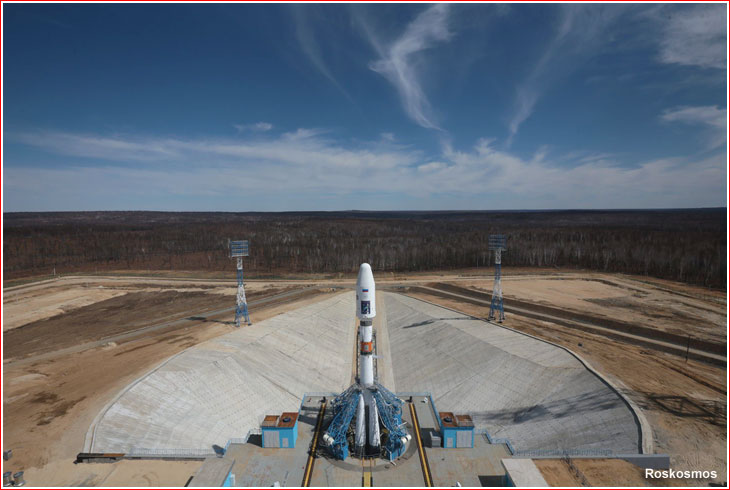
The State Commission overseeing the first launch from Vostochny gave green light to the fueling of the launch vehicle at 21:30 Moscow Time, Roskosmos announced on April 26. The commission was co-chaired by Deputy Director General Aleksandr Ivanov and Deputy Commander of the Russian Air and Space Forces, VKS, Andrei Ivashin. According to Roskosmos, the group was expected to make further decisions on the start of automated sequences for the pre-launch operations of the launch vehicle and on the retraction of the Mobile Service Tower.
The fueling operations were conducted several hours ahead of a routine schedule to provide an extra margin for unexpected technical issues during the first practical use of the launch complex.
The security was also increased around Vostochny due to a visit of the Russian president Vladimir Putin, who was expected to personally witness the launch. Kremlin officials imposed a 10-minute delay on all live broadcasts from the site during the final countdown and launch.
At 02:36 Moscow Time on April 27, Roskosmos announced that based on the results of the fueling, the State Commission had made a decision about readiness of the Soyuz-2-1a rocket for launch. A command activating the automated pre-launch sequence for the launch vehicle and the upper stage, as well as the retraction of the Mobile Service Tower had been issued, Roskosmos said.
Roskosmos did not televise the launch, but sources at the site told RussianSpaceWeb.com, that the launch countdown was automatically aborted after the "Klyuch na Start" (key to launch) command and during the pressurization of the vehicle's tanks, just minutes before a scheduled liftoff on April 27, 2016, at 05:01:21 Moscow Time (11:01 local time; 10:01 p.m. EDT on April 26).
The umbilical cable mast reportedly remained connected to the rocket. According to the official statement from Roskosmos issued around an hour after the scrub, the automated sequence was stopped 1.5 minutes before liftoff.
The problem required to postpone the launch for at least 24 hours and, according to Kremlin's press officials, President Putin would remain at the launch site for another day, hinting a likely launch attempt on April 28.
At 09:23 Moscow Time (1:23 a.m. EDT) on April 27, Roskosmos announced that "the problematic area had been isolated and work had been continuing to find out the exact culprit. There are grounds to believe that problems with the rocket can be resolved during the day," the statement said.
Around 18:00 Moscow Time (11:00 a.m. EDT) on April 27, the State Commission overseeing the first launch from Vostochny gave its green light to another launch attempt on April 28, 2016, at 05:01:21 Moscow Time (11:01 local time; 10:01 p.m. EDT on April 27).
As it transpired, during the first launch attempt, the automated launch control system did not receive a signal confirming an implementation of a command to open a valve leading to the pipeline through the oxidizer tank of the Block I (Stage 3), which had to be filled with fuel before liftoff.
As a result, the launch control system stopped the liftoff sequence. The problem reportedly required to replace an electronics unit and a 2.5-meter cable in the launch equipment, which was completed successfully during the day. However, the high profile of the mission turned this minor technical glitch into a political theater, as the Kommersant daily reported that the head of Roskosmos Igor Komarov, Deputy Prime Minister Dmitry Rogozin and Designer General of NPO Avtomatiki Leonid Shalimov (whose organization produced the faulty hardware) had all received strong reprimands from the Russian president.
According to Shalimov quoted in the Kommersant, engineers came up with three different scenarios that could lead to the launch abort. Unable to pinpoint the problem exactly, engineers working through the night from April 27 to April 28 decided to address all three potential culprits.
April 28: Second launch attempt
At 01:00 on April 28 (5 p.m. EDT on April 27), Roskosmos announced that State Commission gave a green light to the liftoff. This time, the countdown went as scheduled and the Soyuz lifted off as scheduled at 05:01:21 Moscow Time (11:01 local time; 10:01 p.m. EDT on April 27).
Soyuz lifts off from Vostochny!
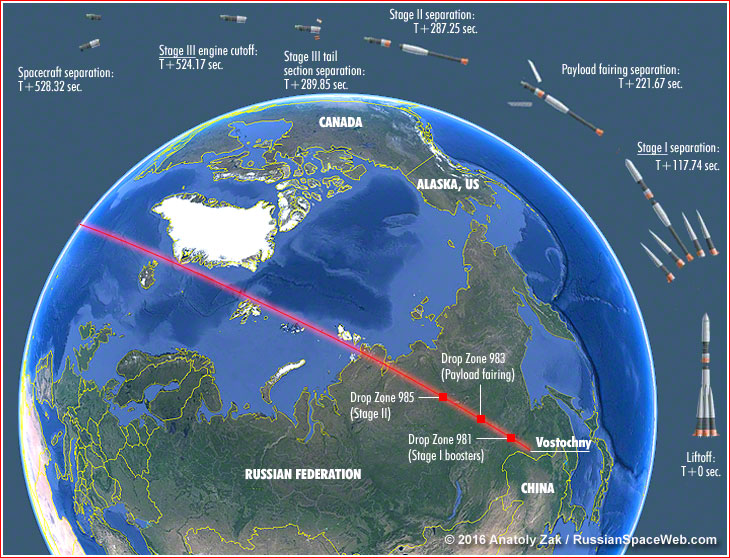
The Soyuz-2-1a/Volga rocket, carrying Mikhailo Lomonosov, Aist-2D and SamSat-218D satellites, lifted off under power of four boosters of the first stage and a core booster of the second stage. For the first time in the Russian space program, the vehicle was expected to carry external video cameras, capturing dramatic footage from a vantage point of an ascending rocket. However no images were available live, except from a local TV station.
The vehicle headed north and slightly west to align its trajectory with the near-polar orbit with an inclination 97.272 degrees toward the Equator.
Four boosters of the first stage separated nearly two minutes into the flight and were expected to crash at Drop Zone No. 981 in the Amurskaya Oblast. According to later reports, a search team located three (out of four) boosters few hours later at the predicted location. The team reported no fuel leaks or fires at the site. The fourth booster was found on May 1.
The fairing protecting the payload split in two halves and separated 3.7 minutes into the flight during the operation of the second stage. The payload fairing was to fall at Drop Zone No. 983 in the Sakha (Yakut) Republic of Russia.
Moments before the second stage completed firing 4.8 minutes into the flight, the RD-0110 engine of the third stage fired through an interstage lattice structure, which then separated along with the second stage.
Just two seconds later, the tail section on the third stage also separated splitting into three segments. Both, the second-stage booster and the segments of the tail section were to fall at Drop Zone No. 985, also in the Sakha Republic. There were unofficial reports on the online forum of the Novosti Kosmonavtiki magazine that the second stage fell into a frozen lake in the Sakha Republic.
The third stage continued firing until 8.7 minutes into the flight, inserting the Volga upper stage and three of its payloads into a slightly elliptical parking orbit. Four seconds after the RD-0110 engine shutdown, the Volga separated from the third stage.
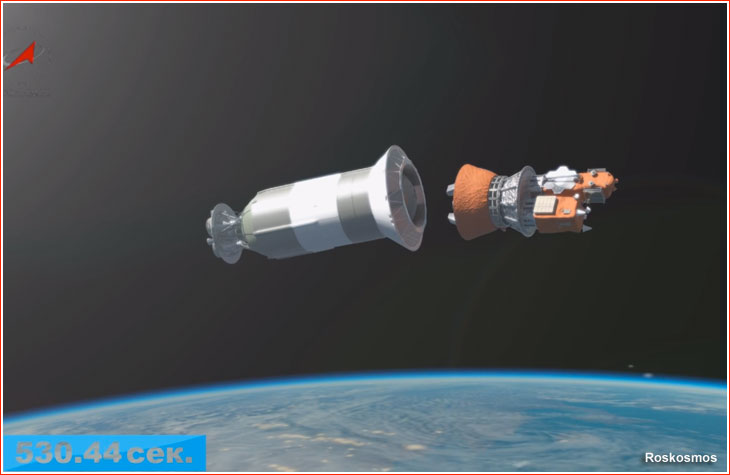
For more than 40 minutes, the space tug and its cargo were in a passive flight, before a moment came for the Volga to fire its engine for the first time. The nearly three-minute maneuver stretched the orbit to a much longer ellipse reaching nearly 500 kilometers above the Earth's surface. For another 45 minutes, the spacecraft climbed passively toward an apogee of its transfer orbit, where Volga re-ignited its engine for nearly two minutes. By that time, it entered a nearly circular orbit just shy of 500 kilometers in altitude.
Less than half an hour after the second engine firing, the tiny SamSat-218D (Kontakt-Nanosputnik) satellite was ejected from its launch container perched on the edge of the Volga's payload adapter. Exactly 10 minutes later, the Mikhailo Lomonosov and Aist-2D satellites also separated from the Volga.
After releasing its cargo, the Volga upper stage was programmed to conduct a deorbiting maneuver sending it to a fiery reentry into the Earth's atmosphere over a remote region of the Pacific Ocean around 12:00 Moscow Time. According to the Russian media, these operations also went as planned. According to the RIA Novosti news agency, quoting the Ministry of Defense, a single braking maneuver sent the stage to its reentry into the Earth's atmosphere at 11:54 Moscow Time and its surviving debris hit the ocean's surface 10 minutes later.
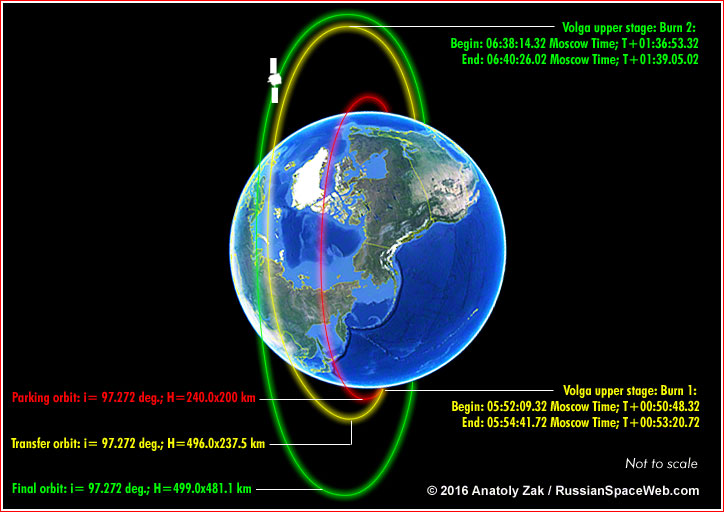
Planned timeline for the 1st launch of the Soyuz rocket from Vostochny on April 27 and 28, 2016:
| Milestone | Elapsed time | Moscow Time |
|---|---|---|
| Liftoff | 0 | 05:01:21 |
| Stage I separation | 117.74 seconds | 05:03:19 |
| Payload fairing separation | 221.67 seconds | 05:05:03 |
| Stage II separation | 287.25 seconds | 05:06:08 |
| Stage III tail section separation | 289.85 seconds | 05:06:11 |
| Stage III engine cutoff | 524.17 seconds | 05:10:05 |
| Volga upper stage separation from Stage III | 528.32 seconds | 05:10:09 |
| Volga stage, Burn 1 to begin | 50 min. 48.32 sec. | 05:52:09.32 |
| Volga stage, Burn 1 to end | 53 min. 20.72 sec. | 05:54:41.72 |
| Volga stage, Burn 2 to begin | 1 hour 36 min. 53.32 sec. | 06:38:14.32 |
| Volga stage, Burn 2 to end | 1 hour 39 min. 05.02 sec. | 06:40:26.02 |
| SamSat-218D separation | 2 hours 05 min. 28.32 sec. | 07:06:49.32 |
| Lomonosov and Aist-2D separation | 2 hours 05 min. 38.32 sec. | 07:06:59.32 |
| Volga upper stage to reenter the Earth's atmosphere | - | 11:54 |
| Debris from Volga upper stage to reach ocean's surface | - | 12:04 |
Post-launch developments
Following the launch from Vostochny, NORAD first catalogued a single object in a 191.7 by 218.7-kilometer orbit with an inclination 97.3 degrees toward the Equator. It could represent either the Volga upper stage in its initial parking orbit before it had a chance to make any maneuvers, or the third stage, which delivered it there.
Soon thereafter, a total of five objects were registered:
| ID | Altitude | Inclination toward the Equator |
|---|---|---|
| 41464U | 472 by 486 kilometers | 97.274 degrees |
| 41465U | 471 by 486 kilometers | 97.272 degrees |
| 41466U | 471 by 486 kilometers | 97.273 degrees |
| 41467U | 187 by 203 kilometers | 97.303 degrees |
| 41468U | 470 by 486 kilometers | 97.273 degrees |
The latest tracking confirmed that Volga delivered and released three of its passengers into orbits with parameters close to planned and only the spent third stage remained in its original orbit.
Shortly after the launch, a correspondent with the Novosti Kosmonavtiki magazine received a text message from the VNIIEM Corporation confirming that antennas and solar panels on the Mikhailo Lomonosov satellite had deployed and it had began sending telemetry and was maintaining proper orientation. On May 6, 2016, Roskosmos announced that testing of scientific instruments onboard Lomonosov was to begin after the completion of ongoing checks of the satellite's service module. According to the agency, all systems onboard Lomonosov were operating as scheduled.
A prominent radio-amateur enthusiast in Russia also reported receiving good signals from the Aist-2D satellite during its three passes at 05:13 UTC, 06:45 UTC and 08:19 UTC on April 28. According to the Samara State Aerospace University, SGAU, its ground control facility made first contact with Aist-2D at 08:11 (Moscow Time). Ground control then began processing telemetry from the satellite, SGAU said.
SamSat-218D did not call home
At the same time, SGAU apparently had problem communicating with the SamSat-218D nano-satellite. On May 4, TASS quoted an unnamed industry source as saying that there had been no contact with the tiny spacecraft since its launch. However a prominent Russian amateur satellite radio enthusiast reported hearing fragments of morse code during the satellite's passes, but could not confirm their authenticity. (Some later attributed these signals to Chinese XW satellites.) By May 6, no signals from the satellite were reported. According to one hypothesis, high-speed tumbling of the satellite acquired during the separation from its launch container could prevent communications with the ground.
In the meantime, the Russian mission control in Korolev also reported that during the mission, it successfully conducted an experimental communications session with the Soyuz launch vehicle via the Luch-5V satellite. The information downlinked during the ascent was also routed to the rocket's manufacturer -- RKTs Progress.
Back on the Soyuz launch complex, a preliminary inspection revealed that the protective shield on the lower service platform, KO, below the launch pad was torn off by the loads during the liftoff. The structure collapsed into the flame trench of the launch pad.
Industry sources also said that, specialists were editing footage obtained by external cameras on the Soyuz rocket (so called "rocketcams"), before it could be released to the general public. Even though the images were beamed to the launch control room in real time during the ascent, officials were apparently scrutinizing the video, so it would not be "misinterpreted" by the press. Obviously, any evidence of damage to the launch pad or to the rocket itself would be prime candidates to be edited out. Perhaps not coincidently, a group of journalists was turned away from the launch pad after the liftoff.
Completing recovery operations at drop zones
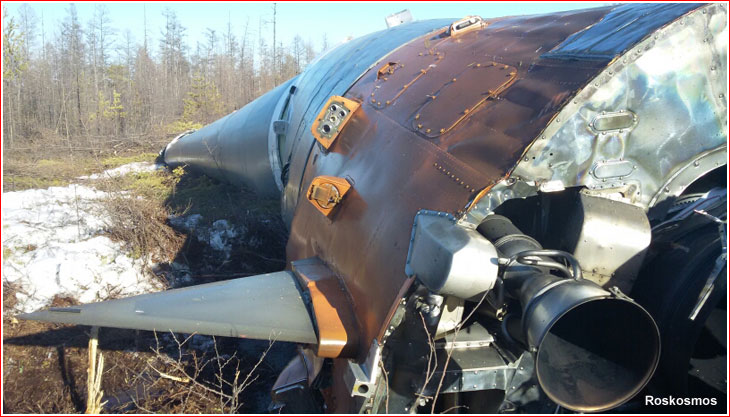
A second-stage booster of the Soyuz rocket in the aftermath of the first launch from Vostochny on April 28, 2016.
For several days after the launch, recovery teams from TsENKI, the main launch processing contractor at Roskosmos, continued search and recovery operations at drop zones downrange from Vostochny.
By May 1, one of four first-stage boosters was cut off into small segments and transported to a transit site near the town of Zeya, from where all the pieces were to be transported back to Vostochny, Roskosmos said.
The search turned out to be much more difficult at Drop Zone No. 985 in the Sakha (Yakut) Republic. A special mobile radar Weibel MFTR-240040 deployed near the city of Vilyusk detected debris from the core stage of the rocket at a distance ranging from 180 to 220 kilometers. It enabled to establish around 17 impact points, which were then photographed from a helicopter. One location was confirmed with a discovery of a combustion chamber from the main engine. However all other sites were difficult to see from the air, due to thick woods and extensive camouflage provided by partially melted snow.
According to Roskosmos, the search was to continue on May 2. However on May 3, the official TASS news agency reported that due to weather conditions in the Yakut Republic all search efforts had been suspended until June, when the snow would not pose a problem. Still, on May 30, more than a month after the launch, both halves of the payload fairing were found in the Aldansky District of the Yakut (Sakha) Republic, according to Roskosmos. Earlier, search teams also recovered 16 fragments of the core stage from the same launch with a total mass of one ton scattered across Vilyusk District (Ulus) of the Yakut Republic, Roskosmos said.
Political fallout
On May 2, the official Russian media reported that Deputy Prime Minister Dmitry Rogozin formed a special investigation commission on the failed launch attempt on April 27. The commission chaired by a member of the Military and Industrial Collegium Oleg Frolov had its first meeting on May 1. On May 4 and May 5, the commission including 20 members visited NPO Avtomatiki in Yekaterinburg. By that time, the company received the cable, whose defective soldering joints were suspected to be a culprit in the launch scrub on April 27. According to the Kommersant newspaper, during the transition from the Malakhit-3 to Malakhit-7 flight control system, one of the umbilical cables leading to the computer was not reconfigured properly for the new design. The problem was missed by the quality control service and could not be detected during tests on the launch pad.
The official goal of the investigative commission was to find causes of the failed launch attempt and to check the completeness of tests leading to the incident.
However given a minor technical impact of the delay, the investigation had primarily political nature, namely it was aimed to demonstrate to the Kremlin that the industry problems were being dealt with. Moreover, Rogozin also made a decision during the work of the commission to suspend the responsibilities of Leonid Shalimov, the Designer General at NPO Avtomatika, which supplied the hardware allegedly responsible for the incident. Rogozin summoned Shalimov to Moscow on May 6, apparently to present the results of the investigation. Around 300 employees from NPO Avtomatika signed an open letter to the president defending their boss.
Read much more about the history of the Russian space program in a richly illustrated, large-format glossy edition:
The article by Anatoly Zak; Last update:May 30, 2016
All rights reserved

